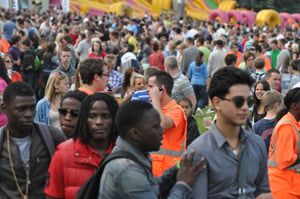Picking up the policing baton
Paul Anderson explains why carnival should be recognised for its contribution to artistic endeavour and community cohesion – not for its policing

2011 will be a year that is remembered for urban riots, with images on television of the police trying to manage these crowds and a big society effort to clean up after them. 2012 is an opportunity for us to put this behind us and to celebrate ‘communities on the streets’ for different reasons as we move towards the Diamond Jubilee and Olympic festivities.
Carnival is a serious artistic endeavour that can bridge the gap between high quality art and big society in a way that very few artforms do. Production and presentation of excellent carnival is an extremely cohesive, creative and highly positive endeavour. Although often associated with the African-Caribbean traditions of Notting Hill, carnival has existed in the UK for many hundreds of years. Participation in carnival often engages whole families across generations, and over months of preparation, creation and performance, so the carnival arts sector needs to have its own narrative about its contribution to building a healthy, vibrant big society, with a primary emphasis on bringing people together in unity and harmony for celebration, not on managing crowds and risk.
Carnival arts and carnival events are becoming ever more popular – Luton International Carnival, for example, is boasted as the largest one day event in Europe. This artform is attracting increased investment from Arts Council England, but is being challenged by excessive policing costs and risk averse regulatory controls implemented often by those who don’t understand the very nature of carnival. This is particularly difficult as the sector relies almost entirely on volunteers for the planning, organising and execution that make carnival a success.
Notting Hill brings 1.5 million people together and contributes £93m to the London economy over its two-day celebration. For the majority, Notting Hill is a family event, yet, it has been marred by a very small number of serious incidents over the years relative to its scale. It is often these incidents that dominate the reporting of carnival, at least in the national press, and are a major influence on the risk management and planning for carnival for the authorities and the police. The resignation of two Notting Hill directors (volunteers) last year shone a light on some of the challenges facing carnival organisers.
Despite the contribution that carnivals make to their local economies, over 90% of their budgets often have to be allocated to the infrastructure for an event and a significant proportion of this can be for policing costs charged to the event. This leaves less than 10% for the art, which has a major impact on investment available for professional carnival artists and hinders the professional development of the sector. Budget priorities can skew the focus and debate of carnival events onto risk management, leaving the art in second place – perhaps the reason why we don’t have carnival ‘artistic’ directors in the UK. Conversations within the sector have revealed that carnival can suffer from a blanket risk management approach because of its association with a specific demographic construct – the young and diverse, who, despite the hard work of many community groups and authorities, are often associated with youth crime, violence, drugs (and now, rioting). We need more dialogue to find a realistic and cost effective way of managing events: the carnival arts sector will continue to build this much needed dialogue with partners, partly to find realistic solutions for managing carnival events but also to ensure that carnival events are led by the art.
Join the Discussion
You must be logged in to post a comment.